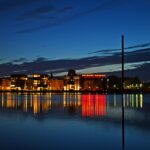The Old Distillery
For many years, Aalborg was almost synonymous with the production of schnapps at De Danske Spritfabrikker. But in 2015 production ended and the buildings were emptied of their original functions. The buildings were listed in 2015 and are the largest industrial preservation in Denmark. The Ministry of Culture has designated the factory as one of the 25 most important industrial monuments in Denmark.
The old distillery's history stretches back to 1846, when Isidor Henius founded the Aalborg Privilegerede Syrups- og Spritfabrik on Urbansgade in Aalborg, the same place where the Cimbrertyren stands on Vesterbro today.
In 1877 the factory had grown to be Denmark's largest, and in 1881 it was merged with several smaller brandy manufacturers, including Brøndum and Harald Jensen Akvavit. Thus De Danske Spritfabrikker was established, with founders CF Tietgen, Isidor Henius and CA Olesen.
In the years that followed, further producers were acquired, and in 1923 all distilleries in Denmark were part of De Danske Spritfabrikker. Thus, De Danske Spritfabrikker had a monopoly on the production of spirits and aquavit in Denmark, a monopoly that lasted until 1973, when Denmark became a member of the EU (then EC).
In 1931 Prime Minister Stauning was able to inaugurate De Danske Spritfabrikker's new factory at the Limfjord in Aalborg. The factory made use of new production methods and became a symbol of industrialization in Denmark.
In 1937, De Danske Spritfabrikker donated the sculpture Kimbrertyren to Aalborg, which was erected on the factory's grounds in Vesterbro. The Kimbrer Bull, created by sculptor Anders Bundgaard, known for creating the Gefion Spring in Copenhagen, still stands today at the distillery. The architect Alfred Cock-Clausen designed the plinth for the bull. The sculpture and its location mark the importance of De Danske Spritfabrikker's presence for the western city and Aalborg.
The former factory area is known today as Spritten and is one of Denmark's largest industrial areas close to the city centre. In 2007, the factory was named a national industrial monument by the Ministry of Culture. The buildings on Spritten are a unique example of a major work in Danish industrial history. Today, the area is rapidly being converted into housing, but support has also been given from Realdania for the construction of an art gallery, etc.

